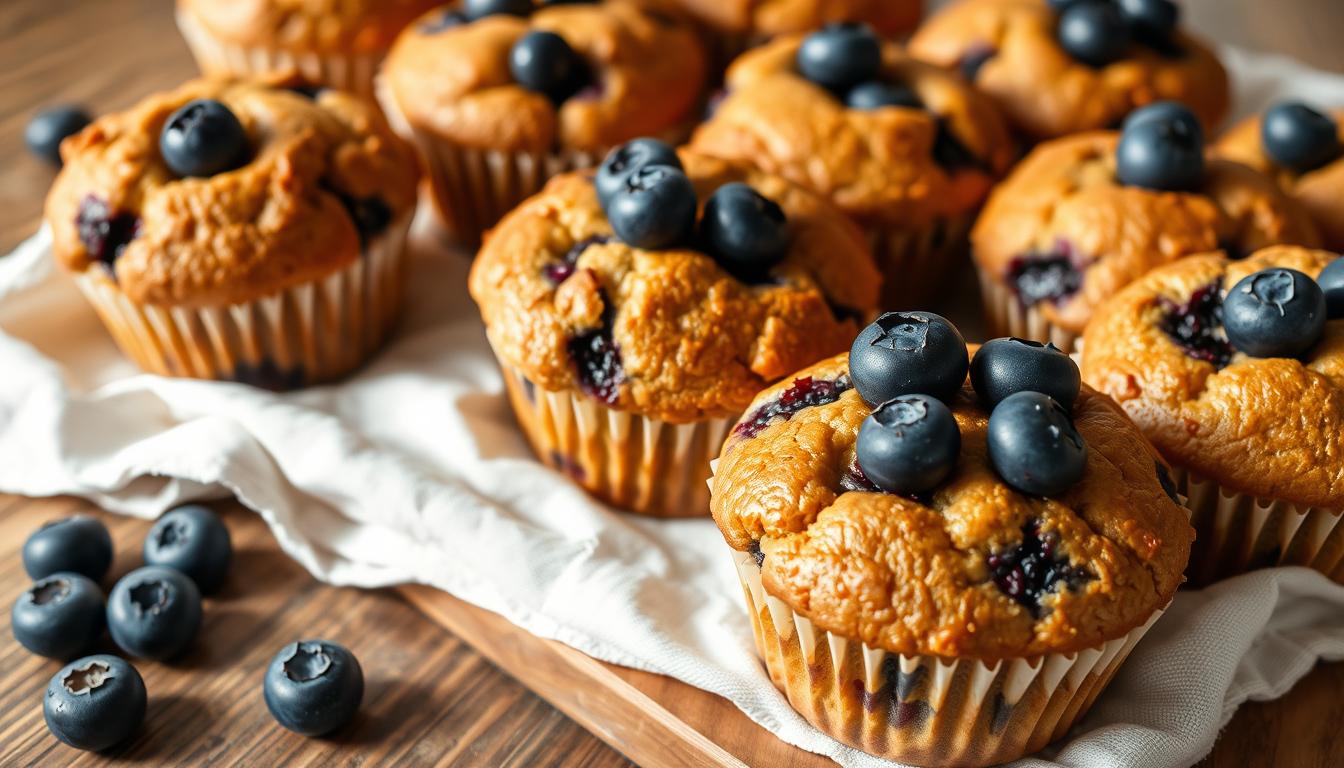Last updated on May 6, 2025
I still remember the first time I tried a gluten-free blueberry muffins. It was love at first bite. The mix of fresh blueberries, gluten-free flour, and sweetness was perfect. I’ve tried many recipes, but this one stands out.
In this article, I’ll share my favorite gluten-free blueberry muffin recipe. You’ll learn about the ingredients, variations, and how to make them.
Gluten-free products are in high demand. This recipe makes delicious and moist muffins. It uses gluten-free flour, almond flour, sugar, eggs, and blueberries. It’s a healthy option for anyone looking for a gluten-free treat.
Whether you’re new to gluten-free baking or an expert, this recipe is perfect. It will become a favorite in your kitchen.
Gluten-free blueberry muffins are great for those with dietary restrictions. This recipe is easy to make and needs just a few ingredients. If you’re looking for a simple gluten-free baking recipe, you’re in the right place.
Table of Contents
Why These Gluten Free Blueberry Muffins Are Special
Gluten-free breakfast ideas are a hit, and homemade blueberry muffins are a top choice. This recipe is tasty and healthier than regular baking. It helps reduce inflammation and improves digestion.
This recipe is perfect for beginners and experts alike. It combines gluten-free flour with almond flour for a light texture and taste. You’ll need 1 3/4 cups of gluten-free flour, 1 cup of sugar, and 2 teaspoons of gluten-free baking powder.
Health Benefits of Gluten-Free Baking
Gluten-free baking is popular for its health perks. It can lower inflammation and boost digestion. This is great for those with gluten issues.
What Makes This Recipe Different
This recipe stands out because it mixes gluten-free flour with almond flour. This gives it a soft texture and flavor. Adding 2 cups of fresh or frozen blueberries adds sweetness and taste.
You can also tweak the recipe. Try using unsweetened almond milk and a streusel topping made with gluten-free flour and sugar.
Preparation and Cooking Time
- Prep Time: 15 minutes
- Cook Time: 20–25 minutes
- Cooling Time: 5 minutes
- Total Time: 40–45 minutes
Ingredients for Gluten-Free Blueberry Muffins
Let’s gather everything you need to make light, fluffy, and deliciously moist gluten-free blueberry muffins! Using high-quality, carefully chosen ingredients will make all the difference in taste and texture.
Dry Ingredients
- 1 ¾ cups gluten-free all-purpose flour blend (with xanthan gum included)
- Tip: Use a reliable brand that works well for baking to get the best results. If your blend doesn’t contain xanthan gum, add ½ teaspoon separately.
- ¾ cup granulated sugar
- Why? This adds just the right level of sweetness to complement the blueberries.
- 2 teaspoons baking powder
- This helps the muffins rise beautifully.
- ½ teaspoon baking soda
- ¼ teaspoon salt
- A small amount enhances the overall flavor.
Wet Ingredients
- 2 large eggs (room temperature)
- Room temp eggs blend more smoothly into the batter.
- ½ cup unsalted butter, melted and slightly cooled
- Butter adds richness, but you can substitute with coconut oil for a dairy-free option.
- 1 cup plain Greek yogurt or sour cream
- This gives the muffins moisture and a tender crumb.
- 1 teaspoon pure vanilla extract
The Star of the Show
- 1 ½ cups fresh blueberries
- Juicy and bursting with flavor! If using frozen berries, don’t thaw them to avoid discoloring the batter.
Optional Add-Ins
- 1 tablespoon lemon zest
- For a bright, citrusy twist.
- 2 tablespoons coarse sugar (for topping)
- Adds a lovely crunch to the muffin tops.
By choosing the right ingredients and paying attention to the little details (like room temp eggs or not overloading the batter with fruit), you’ll set yourself up for muffin success! Up next, we’ll mix everything together — and I’ll share a few pro tips to keep your muffins fluffy and perfectly golden.
There are many substitutes you can use. For example, almond flour can replace gluten-free flour. Frozen blueberries work just as well as fresh ones. These substitutions help you make gluten-free muffins that are perfect for any time.
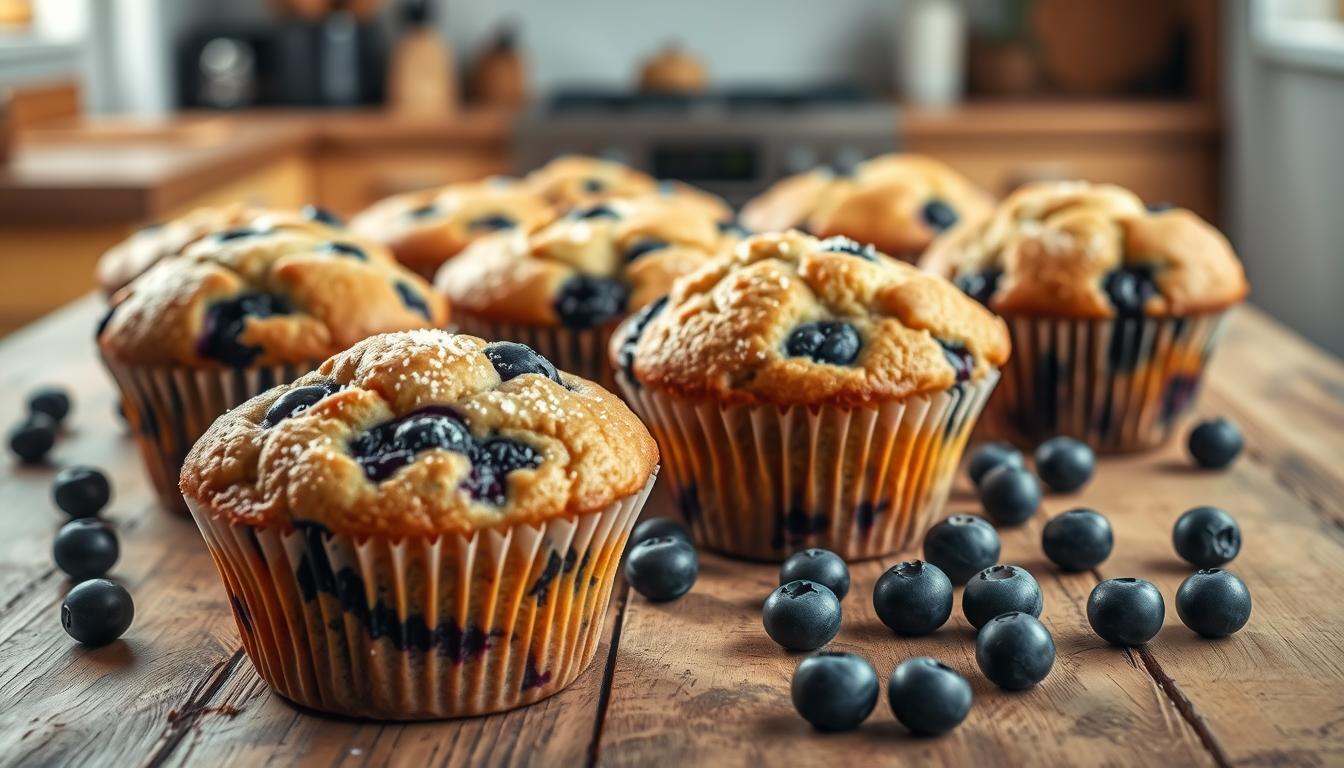
Gluten-Free Flour Options
There are many gluten-free flour options like almond flour, coconut flour, and rice flour. Each flour gives a different texture and taste to your muffins. Choose the one that fits your flavor and texture preferences.
Fresh vs. Frozen Blueberries
You can use fresh or frozen blueberries for your muffins. Fresh ones add a sweet and tangy flavor. Frozen blueberries are convenient and just as tasty. Just thaw and pat dry frozen blueberries to remove extra moisture.
Instructions for Perfect Gluten-Free Blueberry Muffins
Ready to bake some irresistibly fluffy, golden-topped blueberry muffins? Let’s walk through each step together — I’ll share helpful tips along the way to make sure your muffins turn out amazing.

Step 1: Prep Your Kitchen
- Preheat the oven to 375°F (190°C).
- Starting with a hot oven ensures the muffins rise properly and get that signature domed top.
- Line a 12-cup muffin tin with paper liners or lightly grease each cup with nonstick spray.
- Using liners makes cleanup easier and keeps the muffins from sticking.
Step 2: Mix the Dry Ingredients
- In a large bowl, whisk together:
- 1 ¾ cups gluten-free all-purpose flour blend
- ¾ cup granulated sugar
- 2 teaspoons baking powder
- ½ teaspoon baking soda
- ¼ teaspoon salt
- Whisking aerates the flour and evenly distributes the leavening agents, helping the muffins rise evenly.
Step 3: Combine the Wet Ingredients
- In a separate medium bowl, whisk together:
- 2 large eggs (room temperature)
- ½ cup melted unsalted butter (or coconut oil for dairy-free)
- 1 cup plain Greek yogurt or sour cream
- 1 teaspoon vanilla extract
- Make sure the butter isn’t too hot, or it might cook the eggs! Let it cool for a few minutes before adding.
Step 4: Bring the Batter Together
- Pour the wet ingredients into the bowl of dry ingredients.
- Gently fold the mixture with a spatula until just combined.
- Tip: Don’t overmix! A few small flour streaks are okay — overmixing can make the muffins dense.
- Carefully fold in 1 ½ cups fresh blueberries (or frozen, unthawed).
- If using frozen berries, toss them in a tablespoon of flour to help prevent sinking.
Step 5: Fill the Muffin Cups
- Divide the batter evenly between the 12 muffin cups, filling each about ¾ full.
- This gives the muffins enough room to rise without overflowing.
- If desired, sprinkle the tops with coarse sugar for a sweet, crunchy topping.
Step 6: Bake to Perfection
- Bake for 20–25 minutes, or until the tops are golden and a toothpick inserted into the center comes out clean.
- Ovens can vary, so start checking at the 20-minute mark to avoid overbaking.
- Let the muffins cool in the tin for 5 minutes, then transfer to a wire rack to cool completely.
Step 7: Enjoy!
- Serve warm or at room temperature, with a pat of butter or your favorite jam.
- Storage: Keep leftover muffins in an airtight container at room temperature for up to 3 days, or freeze for longer freshness.
Preventing Common Baking Mistakes
Exploring gluten-free breakfast ideas, I found homemade blueberry muffins are a tasty treat. But, making the perfect muffin can be tricky. Here are some tips to help your gluten-free blueberry muffins be light, fluffy, and flavorful.
One big mistake is overmixing the batter, which makes muffins dense. Mix your ingredients gently and briefly. Also, choose the right flour since gluten-free flours act differently. Try different gluten-free flours to find the best one for you.
Avoiding Dense Muffins
To prevent dense muffins, mix ingredients gently and briefly. Overmixing makes gluten-free flours tough and dense. Instead, mix just until combined and stop. This keeps your muffins light and fluffy.
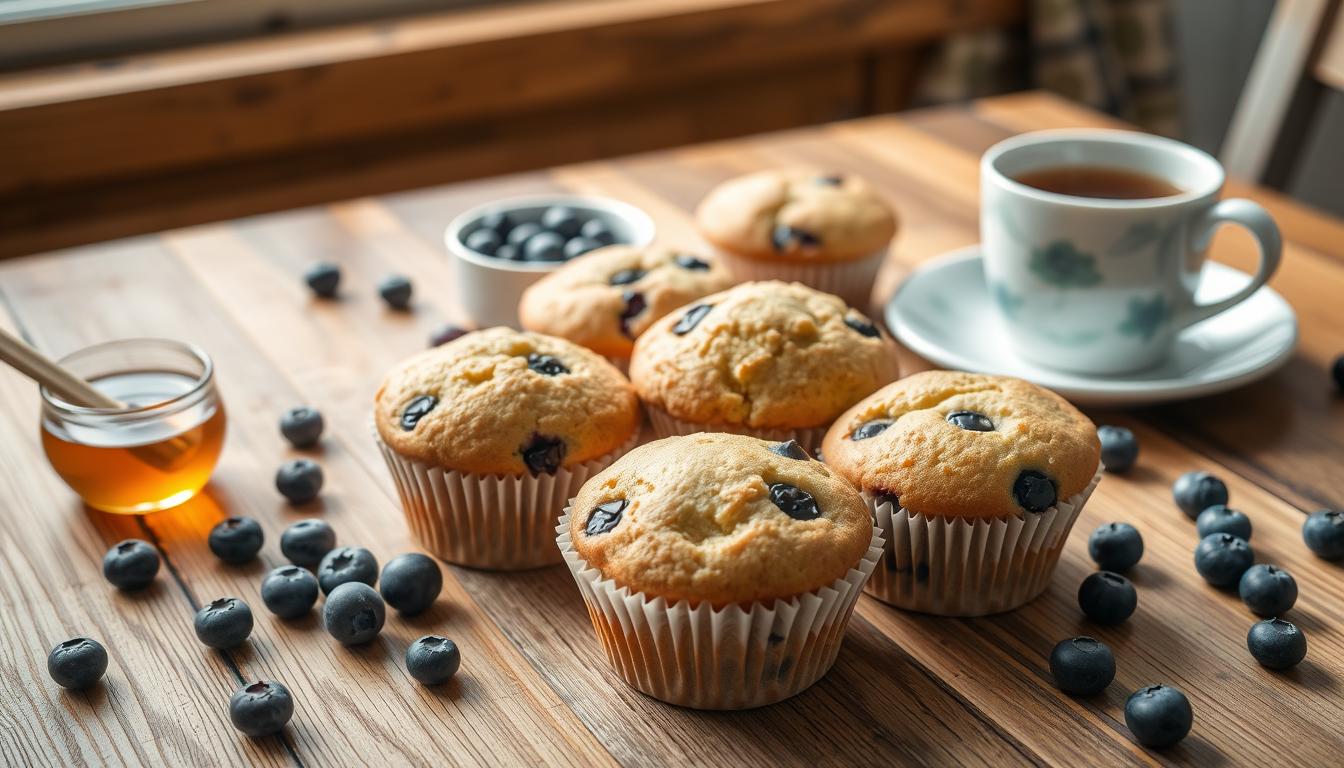
Stopping Blueberry Sink
Not coating blueberries with flour before adding them to the batter is another mistake. This causes blueberries to sink, making the muffin uneven. Coat your blueberries with flour before adding them to the batter. This keeps them evenly distributed in your muffins.
By following these tips, you can make delicious gluten-free blueberry muffins. They’re perfect for starting your day. So, try making them and enjoy the taste of gluten-free breakfast ideas!
Delicious Recipe Variations
Gluten-free blueberry muffins offer endless possibilities. You can add nuts or chocolate chips for a unique taste. Try 1/2 cup of chopped walnuts or 1/2 cup of dark chocolate chips for extra flavor and texture.
Explore different flours like coconut or almond flour. Add spices like cinnamon or nutmeg for a twist. Use almond or soy milk for a dairy-free option. Here are some easy gluten-free muffin ideas:
- Add 1/2 cup of dried cranberries or cherries for a fruity twist
- Use 1/2 cup of coconut sugar instead of granulated sugar for a lower-glycemic option
- Add 1/4 cup of chopped pecans or hazelnuts for added crunch
These ideas help you create gluten-free muffins that fit your taste and diet. With a bit of experimentation, you can make your own unique flavors. Enjoy delicious easy gluten-free muffins anytime you want.
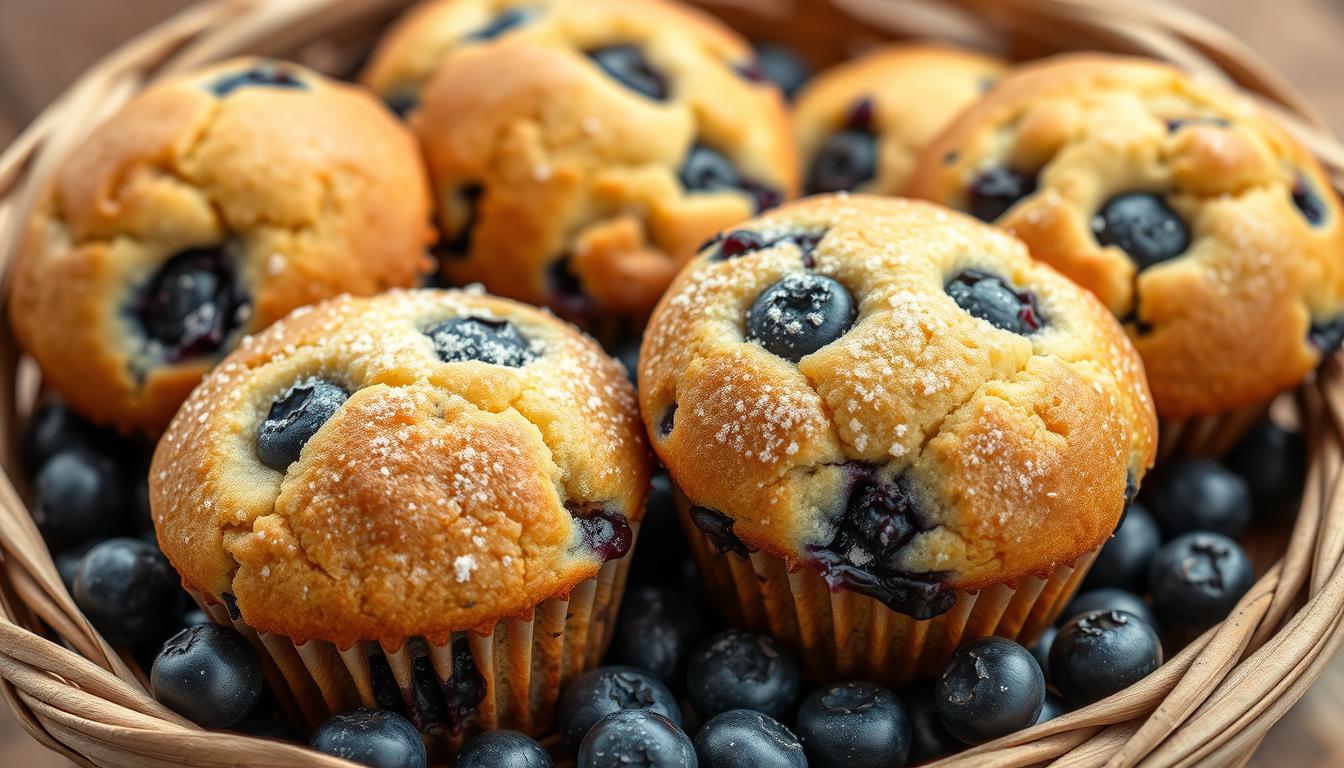
Remember, the secret to great gluten-free muffins is to have fun and experiment. Try new ingredients and flavors. With practice, you’ll master making delicious gluten-free muffins in no time!
| Variation | Ingredients | Instructions |
|---|---|---|
| Nutty Muffins | 1/2 cup chopped walnuts, 1/4 cup chopped pecans | Add to batter and mix well |
| Fruity Muffins | 1/2 cup dried cranberries, 1/4 cup chopped cherries | Fold into batter and mix gently |
| Chocolate Chip Muffins | 1/2 cup dark chocolate chips | Fold into batter and mix well |
Storage Tips and Freshness Guide
Proper storage is key for keeping gluten-free muffins fresh. Cool them for 5 to 10 minutes in the pan before moving to a wire rack. This prevents them from getting soggy or sticking together.
For up to 4 days, store them at room temperature in an airtight container. Watch for mold, which looks like green, blue, or black spots.
Counter Storage Methods
To store muffins at room temperature, use an airtight container. Place them in a single layer, separated by paper towels. This absorbs moisture. You can also use a folded paper towel to fit the container.
Freezing Instructions
Freezing is best for longer storage. Flash freeze the muffins for 2 hours. Then, store them in an airtight container or freezer bag. Frozen muffins stay fresh for up to 2 months.
Reheating Guidelines
To reheat a frozen muffin, wrap it in a damp paper towel. Microwave for 20-30 seconds. This brings back their freshness and texture. You can also reheat at room temperature by wrapping in a paper towel and letting sit for a few hours.
Here’s a quick guide for storing gluten-free blueberry muffins:
| Storage Method | Storage Time | Notes |
|---|---|---|
| Room Temperature | Up to 4 days | Monitor for mold, store in airtight container |
| Refrigeration | Up to 1.5 weeks | Store in airtight container, keep away from strong-smelling foods |
| Freezing | Up to 2 months | Flash freeze, store in airtight container or freezer bag |

Troubleshooting Your Bake
Gluten-free baking can be tricky, but with the right tips, you can make perfect muffins. Issues like dense muffins and blueberries sinking are common. Finding the cause and adjusting the recipe or method is key.
If your muffins are too dense, it might be because you mixed the batter too much or used the wrong flour. Try different ingredients and baking techniques to get it right. Here are some helpful tips:
- Choose the right flour, like almond flour, for gluten-free baking.
- Don’t overmix the batter to avoid dense muffins.
- Put a layer of plain batter at the bottom of each tin before adding blueberries to stop them from sinking.
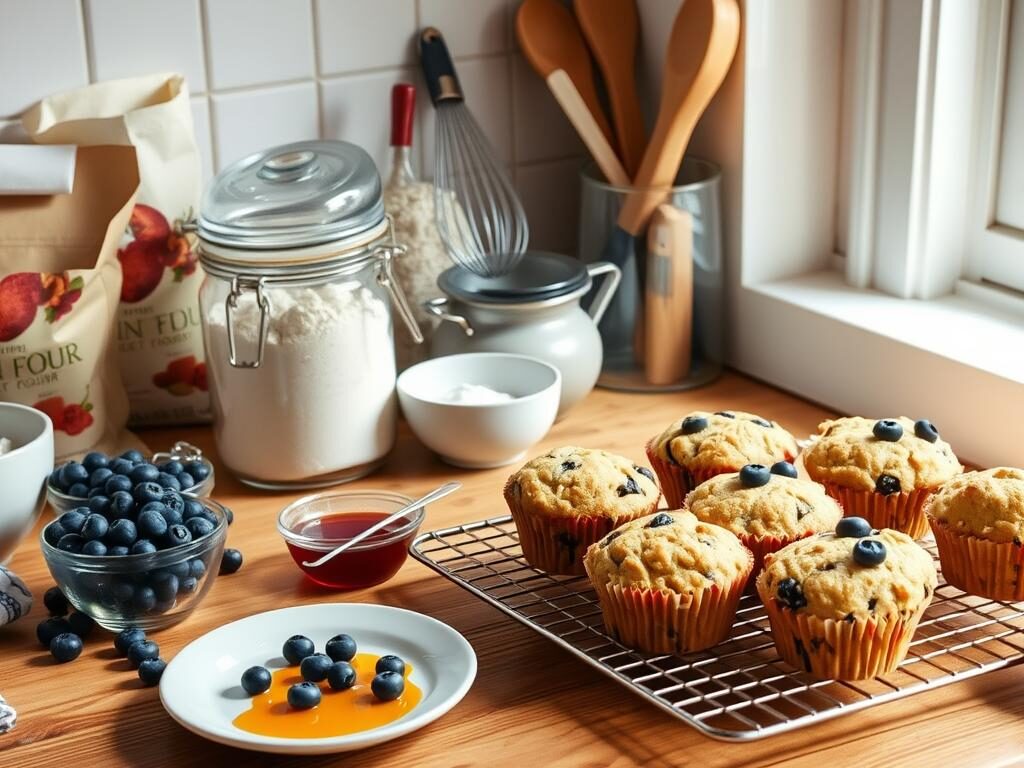
By following these tips, you can fix common problems and make delicious, healthy gluten-free blueberry muffins.
| Troubleshooting Tip | Description |
|---|---|
| Dense Muffins | Check for overmixing or incorrect flour type |
| Blueberry Sink | Add a layer of plain batter at the bottom of each muffin tin |
Conclusion: Your Path to Perfect Gluten-Free Muffins
Making the perfect gluten-free blueberry muffins is an art. It needs patience, trying new things, and facing baking challenges. We’ve shown you how to pick the best gluten-free recipe and mix it right.
The secret to great gluten-free blueberry muffins is finding the right mix of ingredients and techniques. With the tips from this guide, you’ll soon be making muffins that taste like they came from a bakery.
So, get your oven ready, collect your ingredients, and let’s start our gluten-free baking journey. With each batch you make, you’ll get better and more confident. You’ll even get to add your own twist to this classic recipe. Happy baking!
FAQ
What are the key ingredients for gluten-free blueberry muffins?
To make gluten-free blueberry muffins, you need gluten-free flour, sugar, eggs, and blueberries. You can also try almond flour and frozen blueberries for different tastes and diets.
How do I prevent common baking mistakes when making gluten-free muffins?
To avoid dense muffins and blueberries sinking, mix ingredients gently. Use the right flour and coat blueberries with flour. Also, keep the oven at the right temperature for the best texture and taste.
What kind of equipment do I need to bake gluten-free blueberry muffins?
You’ll need a muffin tin, a mixer, a measuring cup, and a digital scale. These tools help you mix and measure ingredients accurately.
Can I make variations to the gluten-free blueberry muffin recipe?
Yes, you can make tasty variations. Try adding nuts, chocolate chips, or spices like cinnamon. Use different flours to experiment and find your favorite.
How should I store gluten-free blueberry muffins to maintain their freshness?
Store muffins in an airtight container at room temperature, in the freezer, or fridge. To reheat, wrap in a damp paper towel and microwave for 20-30 seconds. This keeps them fresh and flavorful.
How do I troubleshoot if my gluten-free blueberry muffins don’t turn out right?
If muffins are dense or have an uneven texture, find the problem and adjust. Try new ingredients and methods to perfect your gluten-free blueberry muffins.

The Best Gluten-Free Blueberry Muffins recipe
- Total Time: 40–45 minutes
- Yield: 12 muffins 1x
Description
These gluten-free blueberry muffins are delightfully moist, fluffy, and bursting with juicy blueberries. Combining a gluten-free flour blend with almond flour, they offer a tender crumb and rich flavor. Perfect for breakfast or a snack, these muffins are easy to make and sure to please everyone.
Ingredients
Dry Ingredients:
- 1 ¾ cups gluten-free all-purpose flour blend (with xanthan gum)
- ¾ cup granulated sugar
- 2 teaspoons baking powder
- ½ teaspoon baking soda
- ¼ teaspoon salt
Wet Ingredients:
- 2 large eggs, room temperature
- ½ cup unsalted butter, melted and slightly cooled (or coconut oil for dairy-free)
- 1 cup plain Greek yogurt or sour cream
- 1 teaspoon pure vanilla extract
Fruit:
- 1 ½ cups fresh blueberries (or frozen, unthawed)
Optional Add-Ins:
- 1 tablespoon lemon zest
- 2 tablespoons coarse sugar (for topping)
Instructions
- Preheat oven to 375°F (190°C). Line a 12-cup muffin tin with paper liners or lightly grease each cup.
- In a large bowl, whisk together the gluten-free flour blend, granulated sugar, baking powder, baking soda, and salt.
- In a separate medium bowl, whisk together the eggs, melted butter (or coconut oil), Greek yogurt (or sour cream), and vanilla extract until smooth.
- Pour the wet ingredients into the dry ingredients and gently fold together until just combined. Do not overmix; a few lumps are okay.
- Gently fold in the blueberries. If using frozen berries, toss them in a tablespoon of flour before adding to prevent sinking.
- Divide the batter evenly among the prepared muffin cups, filling each about ¾ full. Sprinkle tops with coarse sugar if desired.
- Bake for 20–25 minutes, or until the tops are golden and a toothpick inserted into the center comes out clean.
- Allow muffins to cool in the tin for 5 minutes, then transfer to a wire rack to cool completely.
Notes
- For dairy-free muffins, substitute butter with coconut oil and Greek yogurt with a dairy-free yogurt alternative.
- Adding lemon zest enhances the flavor and complements the blueberries.
- To prevent blueberries from sinking, coat them lightly in flour before folding into the batter.
- Store muffins in an airtight container at room temperature for up to 3 days, or freeze for longer storage.
- Prep Time: 15 minutes
- Cook Time: 20–25 minutes
- Category: Breakfast, Snack
- Method: Baking
- Cuisine: Gluten-Free
Nutrition
- Serving Size: 1 muffin
- Calories: 210
- Sugar: 12g
- Sodium: 180mg
- Fat: 10g
- Saturated Fat: undefined
- Unsaturated Fat: undefined
- Trans Fat: undefined
- Carbohydrates: 28g
- Fiber: undefined
- Protein: 4g
- Cholesterol: undefined
Keywords: Gluten-Free Blueberry Muffins, Easy Gluten-Free Muffins, Dairy-Free Muffin Option, Healthy Blueberry Muffins, Almond Flour Muffins

